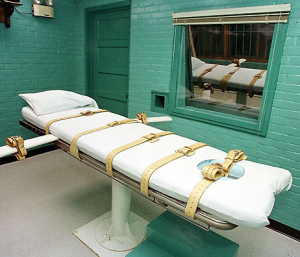 The Marshall project launched last weekend. Though it sounds like a cross between a country/rock band and a plan to rebuild Europe, it’s actually a journalism non-profit focusing on criminal justice. Their first pieces examined federal habeas corpus petitions, those are a key way that federal courts review state criminal convictions. A 1996 law puts significant limits on habeas petitions including a one year filing deadline. The Marshall project notes that the deadline caused some death row prisoners to miss the cut off and and to die without a federal court reviewing their case. But the deadline is not the real problem, and a recent U.S. Supreme Court decision shows how even those who file on time are destined to lose on habeas review.
The Marshall project launched last weekend. Though it sounds like a cross between a country/rock band and a plan to rebuild Europe, it’s actually a journalism non-profit focusing on criminal justice. Their first pieces examined federal habeas corpus petitions, those are a key way that federal courts review state criminal convictions. A 1996 law puts significant limits on habeas petitions including a one year filing deadline. The Marshall project notes that the deadline caused some death row prisoners to miss the cut off and and to die without a federal court reviewing their case. But the deadline is not the real problem, and a recent U.S. Supreme Court decision shows how even those who file on time are destined to lose on habeas review.
The statute that sets that one year deadline is the Antiterrorism and Effective Death Penalty Act of 1996 or AEDPA. The one year filing deadline is a problem but, the bigger issue is the way the AEDPA forces federal courts to deny habeas relief even when a conviction is fundamentally flawed. Case in point is Monday’s Supreme Court decision in Glebe v. Frost.
Joshua Frost’s Trial
Joshua Frost is a Washington man now serving 55 years for a series of robberies in 2003. Frost was charged as an accomplice to other individuals who actually carried out the crimes. He never denied that he drove the other codefendants to the locations of some of the robberies and participated to lesser degrees in other offenses.
Frost’s strategy at trial was to first show that, though he was connected to the crimes, the evidence didn’t prove that he did enough to be an accomplice. Alternatively, he also argued that, even if his participation was enough to make him an accomplice, he only participated under duress; out of fear that the others would hurt him if he refused.
Right before closing arguments, the trial judge told Frost’s attorney that it was legally impossible for him to argue both that Frost was not an accomplice and also to argue duress. As the judge saw it: “a defense of duress admits that the defendant committed the unlawful act but pleas an excuse for doing so. You may not argue both.” Though he disagreed, Frost’s attorney decided to argue duress rather than fight the accomplice liability issue. It didn’t work.
The Appeal
The judge was clearly wrong and, on appeal, the Washington Supreme Court agreed. They found no legal justification for preventing alternative theories of defense. Still, the court allowed the conviction to stand reasoning that the judge’s mistake was a harmless error. They speculated that, no matter what closing argument might have been given, Frost would have been convicted anyway.
Frost petitioned the federal courts for relief through the habeas corpus process and he eventually won when the Ninth Circuit ordered a new trial. That court reasoned that they had no choice but overturn the conviction:
Frost was deprived of his right to demand that a jury find him guilty of all the elements of the crime. The trial court’s action amounted to a directed verdict of guilty. The burden of proof was unconstitutionally shifted. Frost’s right to present a closing argument was violated. These constitutional violations were structural and not subject to harmless error review.
The Supreme Court’s Opinion
The prosecution appealed and, on Monday, the Supreme Court reversed. The Justices agreed that the trial might well have violated Frost’s rights. The problem, they reasoned, is that under the Antiterrorism and Effective Death Penalty act or AEDPA, that’s not enough to reverse a conviction. The violation here, the Court noted, was not so clear as it might have been:
Reasonable minds could disagree whether requiring the defense to choose between alternative theories amounts to requiring the defense to concede guilt. Still more could they disagree whether it amounts to eliminating the prosecution’s burden of proof, shifting the burden to the defendant, or directing a verdict.
Though reasonable minds could disagree, some of those minds, if they were within the Ninth Circuit’s jurisdiction, would be very wrong. That’s because that court had decided in 2000 and 2003 that improper limitation on defense closing argument is a “structural error” invalidating the conviction. In the Ninth Circuit’s Frost decision, the justices cited their 2003 opinion saying:
No matter how “open and shut” the prosecution’s case may seem, there are “cases where closing argument may correct a premature misjudgment and avoid an otherwise erroneous verdict…And there is no certain way for a trial judge to identify accurately which cases these will be, until the judge has heard the closing summation of counsel… For these reasons, we have held that preventing a defendant from arguing a legitimate defense theory constitutes structural error.
But the Supreme Court felt that their hands were tied by the AEDPA because under that act:
the Court of Appeals had power to grant Frost habeas corpus only if the Washington Supreme Court’s decision “was contrary to, or involved an unreasonable application of, clearly established Federal law, as determined by the Supreme Court of the United States,”
Since the Supreme Court had never ruled on the issue there was no “clearly established Federal law” on this question. The mere fact that a federal appeals court thought the trial was constitutionally deficient was not then grounds for reversal.
Hope for Frost?
The good news for Frost is that the Supreme court didn’t snuff out every possible of avenue of relief. They did end with this, suggesting an alternative ground for reversal that might sidestep the AEDPA:
Frost argued below that, even if it was reasonable for the State Supreme Court to treat improper restriction of summation as trial error, it was unreasonable for it to find harmlessness on the facts of this case. The Court of Appeals did not address this argument when sitting en banc, and it is not before us today.
The case was sent back to the Court or Appeals and they just might use the harmless error issue as grounds to reverse the conviction and order a new trial.





